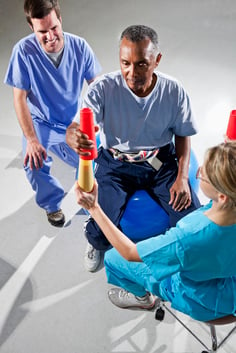Physical and Occupational therapist work together and there are distinct differences. Read more about these specific therapies to support your rehabilitation needs.
At one point or another, most people will need the expertise of an occupational therapist, physical therapist or both. Whether it be recovering from an illness, sports-related injury, post-surgery therapy, or a multitude of other reasons, therapists can do wonders to help their patients regain mobility. If you're thinking that a physical therapist and an occupational therapist sound awfully similar, you are right! However, while they often work together, there are distinct differences between the two. How do you know which one is right for you and what are the main differences between the two?
Choosing a Specific Therapy: What Do You Need to Know?
When deciding which type of therapy is best for you it is important to take the following into consideration:
- What is the nature of the illness or injury?
- What are your overall end goals?
In many cases, patients can benefit from both a physical therapist and an occupational therapist working in conjunction to compliment each other. Let's take an in-depth look at the differences and similarities between the two.

What is Physical Therapy?
Physical therapy primarily focuses on the improvement of gross motor function. Gross motor skills are movements which involve the large muscles, such as the arms, legs, and torso. A physical therapist helps patients regain as much mobility as possible in the affected area after an injury or as a result of an illness or condition. Physical therapy is designed to help the patient regain as much range of motion in the affected body part as possible.
Conditions Treated By a Physical Therapist
Physical therapists are specially trained to treat a variety of disorders and illnesses including:
- Neurological disorders - Stroke, Parkinson's Disease, Multiple Sclerosis
- Cardiopulmonary disorders - Cystic Fibrosis, Post-Myocardial Infarction
- Hand Disorders - Carpal Tunnel, Trigger Finger
- Musculoskeletal - Rotator Cuff, Back Pain, TMJ
- Sports-Related Injuries - Tennis Elbow, Concussions
Physical Therapists' Approach to Treatment
Your physical therapist will first conduct a thorough examination. A treatment plan will be devised based on the findings and include these three main components:
- Prescribed exercise
- Hands-on treatment
- Preventative education
The goal is to not only reduce pain and increase mobility but to also educate patients on a healthy lifestyle that will reduce the risk of incurring another injury or disability in the future. Appropriate exercises are typically prescribed for patients to engage in at home in between scheduled appointments to increase the rate at which you heal.
What is Occupational Therapy?
Occupational therapy is focused more on the improvement of fine motor skills and cognitive skills. The goal of occupational therapy is to help patients be able to navigate their everyday activities (also known as occupations) successfully. Occupational therapists help their patients perform at the highest levels possible in:
- Self-care
- Homemaking
- Leisure
- Social Activities
- Play
Conditions Treated by an Occupational Therapist

- Autism
- Disruptive Mood Regulation Disorder
- Carpal Tunnel Syndrome
- Knee Pain
- Tendonitis
- Stroke Finger
- Arthritis (Thumb and Wrist)
- Tennis Elbow
Occupational Therapists' Approach
Occupational therapists take a holistic approach to treatment. The first step is to conduct a thorough evaluation in which your therapist will determine your long-term personal goals. Your therapist will then create a personalized treatment plan based on your overall goals. Progress evaluations will be conducted throughout the course of treatment to make sure your goals are being reached. Changes will be made if needed.
Rehabilitation Improves Quality of Life
We put our bodies through so much on a day-to-day basis. Taking care of yourself physically, mentally, and emotionally is the key to living life to its fullest. Here at Church Home Lifespring, we are dedicated to both short-term and long-term rehabilitation that empowers our patients to take life by the horns. Contact us today for more information and to schedule an appointment with one of our licensed therapists.

.jpg)